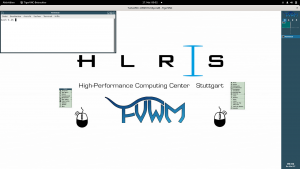- Infos im HLRS Wiki sind nicht rechtsverbindlich und ohne Gewähr -
- Information contained in the HLRS Wiki is not legally binding and HLRS is not responsible for any damages that might result from its use -
Hawk PrePostProcessing
For pre- and post-processing purposes with large memory requirements multi user smp nodes are available. These nodes are reachable via the smp queue. Please see the node types, examples and smp sections of the batch system documentation.
Remote Visualization
Since Hawk is not equipped with Graphic Hardware, remote visualization has either to be executed via the Vulcan cluster or via locally installed clients.
Paraview
ParaView is installed on Hawk with mpi support for parallel execution and rendering on the compute nodes. The installation is available via the module environment.
module load paraview/server/<version>
To enable parallel data processing and rendering on the CPU Paraview is installed with the mesa llvm gallium pipe. This means the Qt based graphical user interface (GUI) i.e. the paraview command and with that the ParaView client is not available. Scripted usage is possible via pvbatch. For interactive parallel post-processing and visualization pvserver has to be used.
Client-Server Execution
Graphical ParaView clients matching the server versions on Hawk are installed on the Vulcan cluster. For efficient connection we recommend to use the vis_via_vnc.sh script available via the VirtualGL module on Vulcan.
ssh vulcan.hww.hlrs.de module load tools/VirtualGL vis_via_vnc.sh
Please note that this will reserve a standard visualization node in Vulcan for one hour. Additional nodes with other graphic hardware are available and the reservation time can of course be increased. for a full list of options please use
vis_via_vnc.sh --help
To connect to the vnc session on the visualization node from your local client computer use one of the methodologies issued by the vis_via_vnc.sh script. The recommended way is to use a TigerVNC viewer or TurboVNC viewer with the -via option.
vncviewer -via <user_name>@cl5fr2.hww.hlrs.de <node_name>:<display_number>
After successfull connection you should be logged in to a remote Xvnc desktop session.
In parallel a regular compute node job has to be requested on Hawk. E.g.
